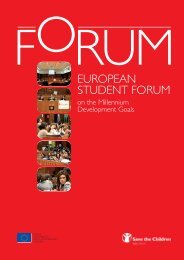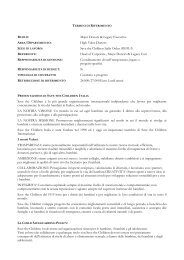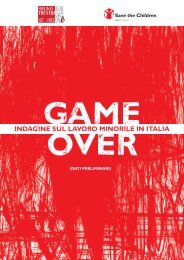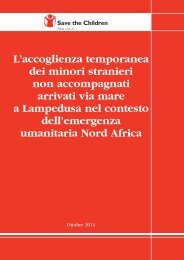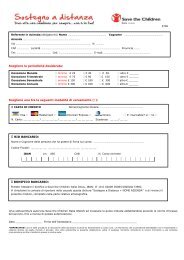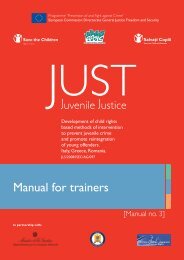FINAL REPORT - Save the Children Italia Onlus
FINAL REPORT - Save the Children Italia Onlus
FINAL REPORT - Save the Children Italia Onlus
You also want an ePaper? Increase the reach of your titles
YUMPU automatically turns print PDFs into web optimized ePapers that Google loves.
<strong>FINAL</strong> <strong>REPORT</strong>Development of a Child Rights Methodology to Identify and Support Child Victims of Trafficking<strong>FINAL</strong> <strong>REPORT</strong>Development of a Child Rights Methodology to Identify and Support Child Victims of TraffickingIn particular, <strong>the</strong> general principles enshrined in <strong>the</strong> CRC underpin <strong>the</strong> approachimplemented in this project, <strong>the</strong>se being:• The best interest of <strong>the</strong> child: it should be <strong>the</strong> primary consideration in all actionsconcerning children (CRC, art. 3).• Non-discrimination: according to this principle, <strong>the</strong> rights of any child should berespected, protected and fulfilled without discrimination of any kind, irrespective of<strong>the</strong> child’s or his or her parent’s or legal guardian’s race, colour, sex, language, religion,political or o<strong>the</strong>r opinion, national, ethnic or social origin, property, legal guardians orfamily members (CRC, art. 2).• Rights to participation: any child, who is capable of forming his or her views has <strong>the</strong>right to express those views freely in all matters affecting him/her and <strong>the</strong> child’s viewsshould be given due weight in accordance with age and maturity. Where possibletrafficked children should <strong>the</strong>refore be involved in decisions affecting <strong>the</strong>m andadequate and age-appropriate information should be supplied to <strong>the</strong>m, for example inrelation to procedures of identification and support (art. 12).• Right to life and to survival and development: every child should be allowed andsupported to develop to his/her full potential. Therefore, this principle acknowledgesthat vulnerable children, such as victims or potential victims of trafficking, should beensured special protection and support and must be given <strong>the</strong> opportunity to be activein <strong>the</strong>ir development (being this an holistic concept, including physical, cognitive,emotional, social, cultural and spiritual development) through <strong>the</strong> use of multidisciplinaryand cross-sectoral approaches (CRC art. 6).In <strong>the</strong> light of <strong>the</strong> above, it is important to clarify that <strong>the</strong> child rights based approachused in this project considers every child as an actor, who should be empowered toactively claim his/her rights. None<strong>the</strong>less, trafficked children are also considered victimsof a web of violations of <strong>the</strong>ir fundamental rights and consequently in need of assistanceand protection. In order to recognise <strong>the</strong>ir vulnerability and provide assistance andprotection in a timely manner, it is a priority and necessity to identify <strong>the</strong>m.The approach described has been applied in <strong>the</strong> analysis of <strong>the</strong> phenomenon of traffickingin <strong>the</strong> project countries, having as focus <strong>the</strong> various stages of <strong>the</strong> trafficking cycle:• vulnerability factors;• recruitment;• journey, transportation, routes followed;• arrival in <strong>the</strong> countries of destination (in <strong>the</strong> case of international trafficking).As a matter of facts, information ga<strong>the</strong>red through this analysis has been considered asfundamental in order to develop indicators of trafficking as part of <strong>the</strong> methodology ofidentification that had to be developed under this project plan.Fur<strong>the</strong>rmore, <strong>the</strong> child rights based approach has been applied in <strong>the</strong> development of <strong>the</strong>rights-based framework used as a tool of analysis of <strong>the</strong> existing practices ormethodologies of identification and support collected in this project.And, most importantly, it has guided <strong>the</strong> development of <strong>the</strong> specific methodology foridentification and support of child victims of trafficking (<strong>the</strong> AGIS methodology).1.4 TERMINOLOGYChild victim of trafficking: In this report a child victim of trafficking is considered tobe any person under eighteen who is recruited, transported, transferred, harboured orreceived for <strong>the</strong> purpose of exploitation, ei<strong>the</strong>r within or outside a country, even if noelement of coercion, deception abuse of authority or any o<strong>the</strong>r form of abuse is used.Trafficking in persons: this report adopts <strong>the</strong> definition of trafficking as given in article 3 of<strong>the</strong> UN Protocol to Prevent, Suppress and Punish Trafficking in Persons, Especially Womenand <strong>Children</strong>, supplementing <strong>the</strong> UN Convention against Transnational Organised Crime(The Palermo Protocol). The first internationally agreed upon definition reads as follows:a) “Trafficking in persons” shall mean <strong>the</strong> recruitment, transportation, transfer,harbouring or receipt of persons, by means of <strong>the</strong> threat or use of force or o<strong>the</strong>r formsof coercion, of abduction, of fraud, of deception, of <strong>the</strong> abuse of power or of aposition of vulnerability or of <strong>the</strong> giving or receiving of payments or benefits toachieve <strong>the</strong> consent of a person having control over ano<strong>the</strong>r person, for <strong>the</strong> purpose ofexploitation.Exploitation shall include, at a minimum, <strong>the</strong> exploitation of <strong>the</strong> prostitution of o<strong>the</strong>rsor o<strong>the</strong>r forms of sexual exploitation, forced labour or services, slavery or practicessimilar to slavery, servitude or <strong>the</strong> removal of organs.b) The consent of a victim of trafficking in persons to <strong>the</strong> intended exploitation set forthin subparagraph (a) of this article shall be irrelevant where any of <strong>the</strong> means set forthin subparagraph (a) have been used.c) The recruitment, transportation, transfer, harbouring or receipt of a child for <strong>the</strong>purpose of exploitation shall be considered “trafficking in persons” even if this doesnot involve any of <strong>the</strong> means set forth in subparagraph (a) of this article.d) “Child” shall mean any person under eighteen years of age.Very importantly, in this project it is acknowledged that trafficking means bothinternational and internal trafficking.Although <strong>the</strong> above given definition of trafficking has been fully incorporated into <strong>the</strong>more recent Council of Europe Convention on Action against Trafficking in HumanBeings 7 (hereinafter CoE Trafficking Convention), in <strong>the</strong> commentary to <strong>the</strong>Convention, it is explained that “transport need not be across a border to be aconstituent of trafficking in human beings” 8 as it is instead in <strong>the</strong> Palermo Protocol. Thisis also pointed out in article 2 of <strong>the</strong> CoE Convention, stating that <strong>the</strong> Conventionequally applies to transnational and national trafficking.Finally, it is important to clarify that in cases of international trafficking, <strong>the</strong> victims isnot required to cross a border illegally. As specified in <strong>the</strong> Explanatory Report to <strong>the</strong> CoEConvention, “Trafficking in human beings can be involved even where a border wascrossed legally and presence on national territory is lawful” 9 .Exploitation: though exploitation is a necessary element in <strong>the</strong> definition of trafficking,it is not <strong>the</strong> same as trafficking which requires a fur<strong>the</strong>r element of “recruitment,transportation, transfer, harbouring or receipt of persons”.The Convention on <strong>the</strong> Rights of <strong>the</strong> Child specifically recognises <strong>the</strong> right of <strong>the</strong> childto be protected from economic exploitation and from performing any work that is likelyto be hazardous or to interfere with <strong>the</strong> child’s education, or to be harmful to <strong>the</strong> child’shealth or physical, mental, spiritual, moral or social development 10 .Given <strong>the</strong> above, child exploitation in an international context is taken to include:Child Labour Exploitation: in this report, <strong>the</strong> definition is taken from <strong>the</strong> ILOConvention on <strong>the</strong> Worst Forms of Child Labour 11 and includes:a) All forms of slavery and practices similar to slavery (...).b) The use, procuring or offering of a child for prostitution, for <strong>the</strong> production ofpornography or for pornographic performances.c) The use, procuring or offering of a child for illicit activities, in particular for <strong>the</strong>production and trafficking of drugs (...).d) Work which, by its nature or <strong>the</strong> circumstances in which it is carried out, is likely toharm <strong>the</strong> health, safety and morals of children.Child exploitation in illicit activities has also been <strong>the</strong> subject of a UN General Assemblyresolution on “The Instrumental Use of <strong>Children</strong> in Criminal Activities” 12 which statedin its Preamble that it considers:“<strong>the</strong> instrumental use of children by adults in profit-making criminal activities is a gravepractice that represents a violation of social norms and a deprivation of <strong>the</strong> right ofchildren to proper development, education and upbringing and prejudices <strong>the</strong>ir future”.And fur<strong>the</strong>rmore, that:“certain categories of children, such as those who are runaway, vagrant, wayward or“street” children, are targets for exploitation, including seduction into drug traffickingand abuse, prostitution, pornography, <strong>the</strong>ft, burglary, begging and homicide for reward”.7Council of EuropeConvention on Actionagainst Trafficking inHuman Beings, CETS197, adopted on 16May 2005 in Warsaw.At <strong>the</strong> moment ofwriting <strong>the</strong> Conventionhas been ratified by 10States and willconsequently enter intoforce on 1 February2008 (Hereinafter“CoE TraffickingConvention”).8Explanatory Report on<strong>the</strong> Council of EuropeConvention on Actionsagainst Trafficking inHuman Beings, para.80 (Hereinafter “CoETrafficking ConventionExplanatory Report”).9CoE TraffickingConventionExplanatory Report,para. 80.10CRC, art. 32 andPreamble to <strong>the</strong> CRCSale of <strong>Children</strong>Protocol.11International LabourOrganisation (ILO)Convention 182 -Worst Forms of ChildLabour, 1999.(Hereinafter ILO 182).12Preamble of <strong>the</strong> UNGeneral AssemblyResolution 45/115“Instrumental Use of<strong>Children</strong> in CriminalActivities”, 14December 1990, athttp://www.un.org/documents/ga/res/45/a45r115.htm14 15



